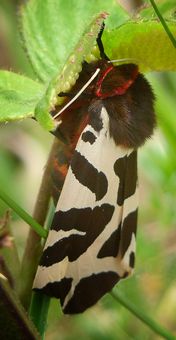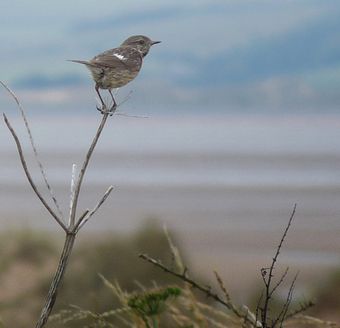 Walney GeraniumWe felt we were a fortunate group of people to experience such good weather for our extended day out visiting North Walney Island. The weather kept fine all day (we had seen some threatening rain clouds on our journey) warm and not windy as predicted. This good fortune spread into the evening when we were able to enjoy spectacular red skies, in particular a view of Ingleborough bathed in a warm red glow, on our return journey.
The island is a habitat consisting of shingle, sand dunes, willow scrub, lakes and grassland (also salt marsh which was not visited) was full of flora and insect life. Our group 15 in number plus 2 travelling by car (Lorna and Andrew) divided into several small groups taking things at their own pace.
Walney GeraniumWe felt we were a fortunate group of people to experience such good weather for our extended day out visiting North Walney Island. The weather kept fine all day (we had seen some threatening rain clouds on our journey) warm and not windy as predicted. This good fortune spread into the evening when we were able to enjoy spectacular red skies, in particular a view of Ingleborough bathed in a warm red glow, on our return journey.
The island is a habitat consisting of shingle, sand dunes, willow scrub, lakes and grassland (also salt marsh which was not visited) was full of flora and insect life. Our group 15 in number plus 2 travelling by car (Lorna and Andrew) divided into several small groups taking things at their own pace.  Grayling on Sea HollyThe most intrepid duo of the party made for the more northerly dune system reporting back that they had walked 5 miles and seen the Walney geranium in good numbers, marsh helleborine but not the dune or green flowered orchid. The majority of the party combed the more southerly dunes for the special plants. There was lots to see and identify. On the shingle banks were sea kale, sea sandwort and yellow horned poppy. In the dunes and margins we saw seaside centaury, thyme, harebells, sea holly, sea spurge, sea bindweed, rose of rugosa, sea rocket, cat's ear, rest harrow, heartease pansy, bird's foot trefoil, biting stonecrop, lady's bedstraw, eyebright, harestail clover, yellow rattle, toadflax, early marsh orchid and parsley water dropwort.
Grayling on Sea HollyThe most intrepid duo of the party made for the more northerly dune system reporting back that they had walked 5 miles and seen the Walney geranium in good numbers, marsh helleborine but not the dune or green flowered orchid. The majority of the party combed the more southerly dunes for the special plants. There was lots to see and identify. On the shingle banks were sea kale, sea sandwort and yellow horned poppy. In the dunes and margins we saw seaside centaury, thyme, harebells, sea holly, sea spurge, sea bindweed, rose of rugosa, sea rocket, cat's ear, rest harrow, heartease pansy, bird's foot trefoil, biting stonecrop, lady's bedstraw, eyebright, harestail clover, yellow rattle, toadflax, early marsh orchid and parsley water dropwort.  Tiger MothThe dune slacks were comparitively dry and not that productive.
In the wetland surrounding the lagoons we saw loosetrife, marsh woundwort, water crowfoot and numerous small frogs ( the pools are the breeding grounds for the natterjack toad). In the grassland area we enjoyed banks of bloody cranesbill and on the small patches of acid heath ling and bell heather.
Tiger MothThe dune slacks were comparitively dry and not that productive.
In the wetland surrounding the lagoons we saw loosetrife, marsh woundwort, water crowfoot and numerous small frogs ( the pools are the breeding grounds for the natterjack toad). In the grassland area we enjoyed banks of bloody cranesbill and on the small patches of acid heath ling and bell heather.  Young StonechatWe did not get as far as the eastern shore to take in the plants of the salt marsh.
Several butterflies were on the wing. Of special interest was the grayling butterfly with its superb camouflage when still. Other butterflies seen were the gatekeeper and red admiral. The bird life was more limited however we obtained a good view of a flock of young stonechats and an adult male. Other birds were meadow pipit, oystercatcher and blackheaded gull.
The meal at the Gilpin Bridge hotel satisfied all appetites and tastes! We returned to Bradford tired but stimulated as a result of an inspiring day out in the field. Thanks go to Brian (and his helpers) for being prepared to take on this one despite the distance involved and for doing those two reckies.
Young StonechatWe did not get as far as the eastern shore to take in the plants of the salt marsh.
Several butterflies were on the wing. Of special interest was the grayling butterfly with its superb camouflage when still. Other butterflies seen were the gatekeeper and red admiral. The bird life was more limited however we obtained a good view of a flock of young stonechats and an adult male. Other birds were meadow pipit, oystercatcher and blackheaded gull.
The meal at the Gilpin Bridge hotel satisfied all appetites and tastes! We returned to Bradford tired but stimulated as a result of an inspiring day out in the field. Thanks go to Brian (and his helpers) for being prepared to take on this one despite the distance involved and for doing those two reckies. Margaret
